Mercedes-Benz A-CLASS SEDAN 2020 Emergency User Manual
Introduction
Welcome to the world of automotive perfection, where performance and luxury converge with innovation and grace. The 2020 Mercedes-Benz A-Class Sedan, a true masterpiece that raises the bar for compact luxury, is what we are most excited to introduce to you today. The need of safety, style, and sophistication has never been greater than it is today in a world that is moving at an accelerating rate. The Mercedes-Benz brand’s unwavering quest of excellence is embodied in the 2020 A-Class Sedan, which provides the solution to these expectations. This sedan’s design, which was created with extreme care and attention to detail, emanates a classic elegance that catches everyone’s attention.
But this beauty goes beyond the surface. With its extensive list of cutting-edge safety systems, the 2020 A-Class Sedan raises the bar for on-road security. Mercedes-Benz takes every precaution to protect its passengers, from sophisticated driver aid systems to improved structural integrity. A balanced combination of power and efficiency is waiting underneath the hood. The 2020 A-Class Sedan is designed to provide an exhilarating driving experience with responsive handling and smooth acceleration that is fuel-efficient and thrilling on every journey. Additionally, the twin widescreen displays on the Mercedes-Benz User Experience (MBUX) infotainment system turn driving into a connected and intuitive experience. A wealth of digital features, voice commands, and touch controls guarantee easy interaction with your daily activities.
Emergency
Removing the safety vest
The safety vests are located in the safety vest compartments in the driver’s and front passenger door stowage compartments.
- To remove: pull out safety vest bag 1 by loop 2.
- Open safety vest bag 1 and pull out the safety vest.
There are also safety vest compartments in the rear door stowage compartments in which safety vests can be stored.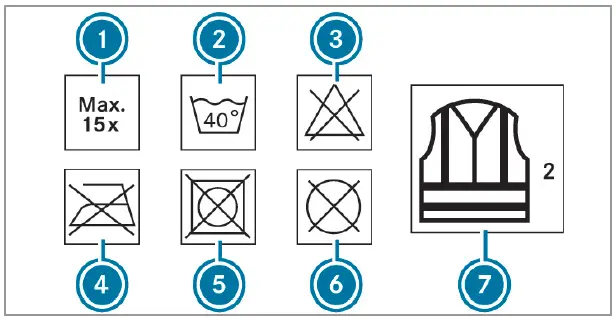
- Maximum number of washes
- Maximum wash temperature
- Do not bleach
- Do not iron
- Do not tumble dry
- Do not dry clean
- Class 2 safety vest
The requirements defined by the legal standard are only fulfilled if the safety vest is the correct size and is fully closed.
The safety vest must be replaced in the following situations:
- the reflective strips are damaged or dirty
- the maximum permissible number of washes is exceeded
- the fluorescence has faded
Flat tire
Notes on flat tires
WARNING
Risk of accident due to a flat tire flat tire severely affects the driving characteristics as well as the steering and braking of the vehicle.
Tires without run-flat characteristics:
- Do not drive on with a flat tire.
- Change the flat tire immediately with an emergency spare wheel or spare wheel.
Alternatively, consult a qualified spe‐cialist workshop.
Tires with run-flat characteristics:
Observe the information and warning notes on MOExtended tires (run-flat tires).
In the event of a flat tire, the following options are available depending on your vehicle’s equip‐ment:
- Vehicles with MOExtended tires: it is possible to continue the journey for a short period of time. Make sure you observe the notes on MOExtended tires (run-flat tires).
- Vehicles with a TIREFIT kit: you can repair the tire so that it is possible to continue the journey for a short period of time. To do this, use the TIREFIT kit.
- Vehicles with Mercedes me connect: you can make a call for breakdown assistance via the overhead control panel in the case of a breakdown.
- All vehicles: change the wheel.
- The emergency spare wheel is only available in certain countries.
Notes on MOExtended tires (run-flat tire)
WARNING
Risk of accident when driving in emergency mode
When driving in emergency mode, the han‐dling characteristics are impaired. e.g. when cornering, when accelerating strongly and when braking.
- Do not exceed the permissible maxi‐mum speed for MOExtended tires.
- Avoid any abrupt steering and driving maneuvers as well as driving over obstacles (curbs, pot holes, off-road). This applies, in particular, to a loaded vehicle.
- Stop driving in the emergency mode if you notice:
- banging noise
- vehicle vibration
- smoke which smells like rubber
- continuous ESP® intervention
- cracks in tire side walls
- After driving in emergency mode have the rims checked by a qualified special‐ist workshop with regard to their further use.
- The defective tire must be replaced in every case.
With MOExtended tires (run-flat tire), you can continue to drive your vehicle even if there is a total loss of pressure in one or more tires. How‐ever, the tire affected must not show any clearly visible damage.
You can recognize MOExtended tires by the MOExtended marking which appears on the side wall of the tire. Vehicles with tire pressure loss warning sys‐tem: MOExtended tires may only be used in conjunction with an activated tire pressure loss warning system. Vehicles with tire pressure monitoring sys‐tem: MOExtended tires may only be used in con‐junction with an activated tire pressure monitor‐ing system.
If a pressure loss warning message appears in the multifunction display, proceed as follows:
- Check the tire for damage.
- If driving on, observe the following notes.
Driving distance possible in emergency mode after the pressure loss warning:
| Load condition | Driving distance pos‐ sible in emergency mode |
| Partially laden | 50 miles (80 km) |
| Fully laden | 19 miles (30 km) |
The driving distance possible in emergency mode may vary depending on the driving style. Observe the maximum permissible speed of 50 mph (80 km/h). If a tire has gone flat and cannot be replaced with an MOExtended tire, you can use a stand‐ard tire as a temporary measure.
TIREFIT kit storage location
The TIREFIT kit is located under the trunk floor.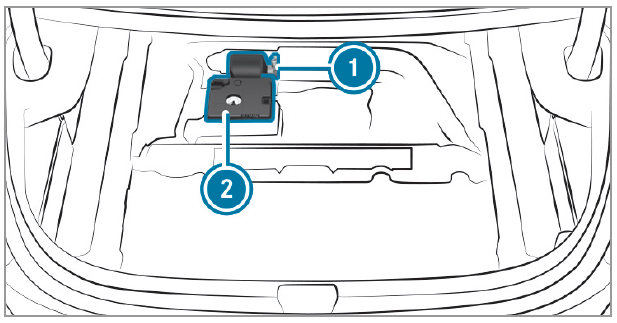
- Tire sealant bottle
- Tire inflation compressor
Using the TIREFIT kit
Requirements
Required tools:
- Tire sealant bottle
- TIREFIT sticker
- Sticker with details of the maximum permissible speed
- Tire inflation compressor
- Gloves
TIREFIT kit storage location: You can use TIREFIT tire sealant to seal perforation damage of up to 0.16 in (4 mm), particularly those in the tire contact surface. You can use TIREFIT in outside temperatures down to -4 °F (-20 °C).
WARNING
Risk of an accident when using tire sealant
In the following situations in particular, the tire sealant is unable to provide sufficient breakdown assistance, as it is unable to seal the tire properly:
- There are cuts or punctures in the tire larger than those previously mentioned.
- The wheel rim is damaged.
- You have driven at very low tire pressure or on a flat tire.
- Do not drive on.
- Consult a qualified specialist workshop.
WARNING
Risk of injury and poisoning from tire sealant
The tire sealant is harmful and causes irritation. Do not allow it to come into contact with the skin, eyes or clothing, and do not swallow it. Do not inhale tire sealant fumes. Keep the tire sealant away from children.
If you come into contact with the tire sealant, observe the following:
- Rinse off the tire sealant from your skin immediately using water.
- If tire sealant gets into your eyes, thor‐oughly rinse out the eyes using clean water.
- If tire sealant has been swallowed, immediately rinse out the mouth thor‐oughly and drink plenty of water. Do not induce vomiting and seek medical attention immediately.
- Change out of any clothes contamina‐ted with tire sealant immediately.
- If allergic reactions occur, seek medical attention immediately.
NOTE
Overheating due to the tire infla‐tion compressor running too long
Do not run the tire inflation compressor for longer than ten minutes without interruption.
Comply with the manufacturer’s safety notes on the sticker on the tire sealant bottle.
Have the tire sealant bottle replaced at a qualified specialist workshop every five years.
- Do not remove any foreign objects which have entered the tire.

- Remove sticker 1 from the tire inflation compressor housing and affix it to the instrument cluster within the driver’s field of vision.
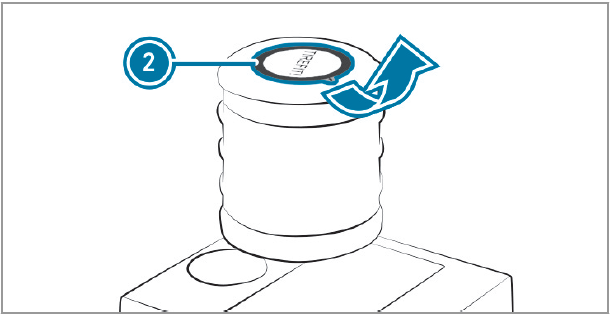
- Remove sticker 2 from the tire sealant bottle and affix it near the valve on the wheel with the faulty tire.
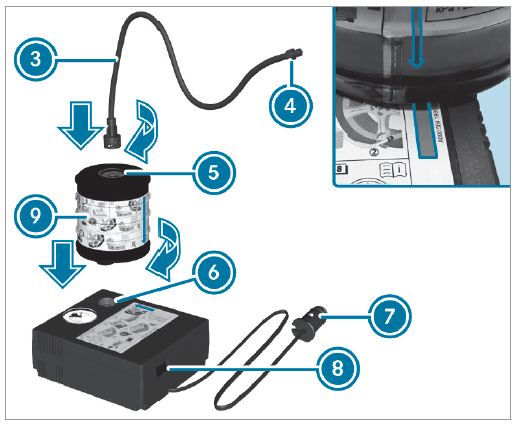
- Pull plug 7 with the cable and filler hose 3 out of the tire inflation compressor housing.
- Insert tire sealant bottle 9 in socket 6 of the tire inflation compressor in such a way that the red arrow on tire sealant bottle 9 matches the red arrow on the tire inflation compressor.
- Then turn the tire sealant bottle 9 a quarter turn clockwise.
- Insert the plug of filler hose 3 in socket 5 of tire sealant bottle 9.
- Then turn filler hose 3 a quarter turn clockwise.
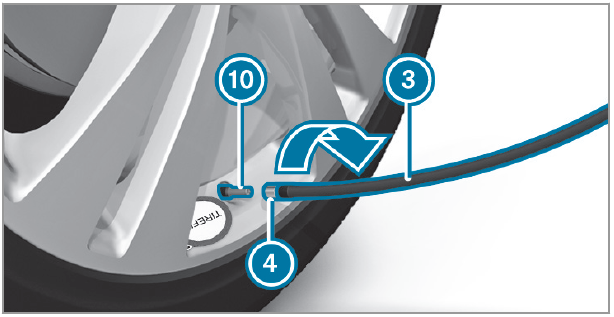
- Remove the valve cap from valve A on the faulty tire.
- Screw union nut 4 of filler hose 3 onto valve A.
- Insert plug 7 into a 12 V socket in your vehicle.
- Turn the SmartKey to position 1 in the ignition lock.
- Press on and off switch 8 on the tire inflation compressor.
The tire inflation compressor is switched on. The tire is inflated. First, tire sealant is pumped into the tire. The pressure may briefly rise to approximately 500 kPa (5 bar/73 psi).
Do not switch off the tire inflation compressor during this phase.
Let the tire inflation compressor run for a maximum of ten minutes.
The tire should then have attained a tire pressure of at least 200 kPa (2.0 bar/ 29 psi).
If tire sealant leaks out, make sure you clean the affected area as quickly as possible. It is preferable to use clean water.
If you get tire sealant on your clothing, have it cleaned as soon as possible with perchloroethylene?
If, after ten minutes, a tire pressure of 200 kPa (2.0 bar/29 psi) has not been achieved:
- Switch off the tire inflation compressor.
- Unscrew the filling hose from the valve of the faulty tire.
- Please note that tire sealant may leak out when unscrewing the filling hose.
- Drive forwards or reverse very slowly for approximately 33 ft (10 m).
- Pump up the tire again.
After a maximum of ten minutes, the tire pressure must be at least 200 kPa (2.0 bar/ 29 psi).
WARNING
Risk of accident due to the specified tire pressure not being reached
If the specified tire pressure is not reached after the specified time, the tire is too badly damaged. The tire sealant cannot repair the tire in this instance.
Damaged tires and tire pressure that is too low can significantly impair braking and handling characteristics.
- Do not continue driving.
- Consult a qualified specialist workshop.
After use, excess tire sealant may leak out from the filling hose.
Therefore, place the filling hose in the plastic bag that contained the TIREFIT kit.
If, after ten minutes, a tire pressure of 200 kPa (2.0 bar/29 psi) has been achieved:
- Switch off the tire inflation compressor.
- Unscrew the filling hose from the valve of the faulty tire.
Please note that tire sealant may leak out when unscrewing the filling hose.
WARNING
Risk of accident from driving with sealed tires
A tire temporarily sealed with tire sealant impairs driving characteristics and is not suitable for higher speeds.
- Adapt your driving style accordingly and drive carefully.
- Do not exceed the maximum speed limit with a tire that has been repaired using tire sealant.
- Observe the maximum permissible speed for a tire sealed with tire sealant 50 mph (80 km/h).
- The sticker with details of the maximum permissible speed must be affixed to the instrument cluster where it can be easily seen by the driver.
NOTE
Staining caused by leaking tire sealant
After use, excess tire sealant may leak out from the filling hose.
- Therefore, place the filling hose in the plastic bag that contained the TIREFIT kit.
ENVIRONMENTAL NOTE
Environmental pollution caused by environmentally irresponsible disposal
Tire sealant contains pollutants.
Have the tire sealant bottle disposed of professionally, e.g. at an authorized Mercedes-Benz Center.
- Stow the tire sealant bottle and the tire inflation compressor.
- Pull away immediately.
- Stop driving after approximately ten minutes and check the tire pressure using the tire inflation compressor.
The tire pressure must now be at least 130 kPa (1.3 bar/19 psi).
WARNING
Risk of accident due to the specified tire pressure not being reached
If the specified tire pressure is not reached after a brief drive, the tire is too badly dam‐aged. The tire sealant cannot repair the tire in this instance.
Damaged tires and tire pressure that is too low can significantly impair the braking properties and handling characteristics.
- Do not continue driving.
- Consult a qualified specialist workshop.
In cases such as the one mentioned above, contact an authorized Mercedes-Benz Center. Or call 1-800-FOR-MERCedes (in the USA) or 1-800-387-0100 (in Canada).
- Correct the tire pressure if it is still at least 130 kPa (1.3 bar/19 psi). See the Tire and Loading Information placard on the B‑pillar on the driver’s side or the tire pressure table in the fuel filler flap for values.
- To increase the tire pressure: switch on the tire inflation compressor.
- To reduce the tire pressure: remove the tire sealant bottle from the tire inflation compressor.
- Insert the filler hose in the socket of the tire inflation compressor and turn it a quarter turn clockwise.
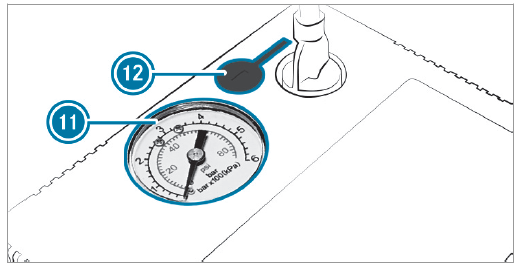
- Press pressure release button C next to manometer B.
- When the tire pressure is correct, unscrew the filling hose from the valve of the sealed tire.
- Screw the valve cap onto the valve of the sealed tire.
- Stow the tire sealant bottle and the tire inflation compressor.
- Drive to the nearest qualified specialist work‐shop and have the tire, tire sealant bottle, and filling hose replaced there.
FAQs
Yes, an emergency brake assist technology that automatically applies brakes in an emergency is standard on the 2020 A-Class Sedan, helping to reduce crashes.
Yes, a tire pressure monitoring system that warns the driver if a tire’s pressure deviates from the recommended range is included in the 2020 A-Class Sedan.
Yes, the 2020 A-Class Sedan is equipped with Mercedes-Benz’s emergency communication system, referred to as “Mercedes-Benz Emergency Call,” which can automatically notify emergency services in the event of a serious accident.
Without a doubt, the 2020 A-Class Sedan has numerous airbags to safeguard occupants in the event of a collision, including front, side, curtain, and knee airbags.
The enhanced Electronic Stability Program (ESP) in the 2020 A-Class Sedan includes traction control, improving stability and control during emergency maneuvers.
Yes, the 2020 A-Class Sedan has a temporary spare tire that you can use to temporarily replace a flat tire until you can go to a service center.
To help avert and lessen potential emergencies, the 2020 A-Class Sedan provides a number of driver assistance functions like Active Brake Assist, Attention Assist, and Blind Spot Assist.
In order to safeguard occupants during rollover occurrences, the 2020 A-Class Sedan has a robust body structure, crumple zones, and rollover sensors.
Yes, the 2020 A-Class Sedan has Lane Keeping Assist, which gently directs the car back into its lane to help avoid unintended lane departure.
Yes, the 2020 A-Class Sedan has Attention Assist, a device that keeps track of driver behavior and issues warnings when it notices signs of weariness.
The 4MATIC all-wheel-drive system in the 2020 A-Class Sedan improves traction and stability on slick or low-traction surfaces.
Yes, the 2020 A-Class Sedan has ISOFIX anchors and tethers for child seats to be secured, ensuring the security of the little occupants.
The 2020 A-Class Sedan automatically unlocks the doors, turns on the danger lights, and cuts off the fuel supply in the event of a collision to reduce additional hazards.
Some variants of the 2020 A-Class Sedan might include a first aid kit and other emergency supplies, though this could vary by location and trim level.
A specific Mercedes-Benz Roadside Assistance service is offered by the 2020 A-Class Sedan, and it may be contacted via the infotainment system of the car or by dialing a toll-free number listed in the owner’s manual.
Useful Links
Download Manuals: Owner’s Manuals | Mercedes-Benz USA
View Full Manual: Mercedes-Benz A-CLASS SEDAN 2020 User Manual


